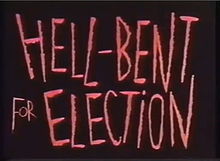
The 1944 United States presidential election was the 40th quadrennial presidential election. It was held on Tuesday, November 7, 1944. The election took place during World War II, which ended the following year. Incumbent Democratic President Franklin D. Roosevelt defeated Republican Thomas E. Dewey to win an unprecedented fourth term. It was also the fifth presidential election in which both major party candidates were registered in the same home state; the others have been in 1860, 1904, 1920, 1940, and 2016.

United Productions of America, better known as UPA, was an American animation studio and later distribution company founded in 1941 as Industrial Film and Poster Service by former Walt Disney Productions employees. Beginning with industrial and World War II training films, UPA eventually produced theatrical shorts for Columbia Pictures such as the Mr. Magoo series. In 1956, UPA produced a television series for CBS, The Boing-Boing Show, hosted by Gerald McBoing Boing. In the 1960s, UPA produced syndicated Mr. Magoo and Dick Tracy television series and other series and specials, including Mister Magoo's Christmas Carol. UPA also produced two animated features, 1001 Arabian Nights and Gay Purr-ee, and distributed Japanese films from Toho Studios in the 1970s and 1980s.

The golden age of American animation was a period in the history of U.S. animation that began with the popularization of sound synchronized cartoons in 1928 and gradually ended in the 1960s when theatrical animated shorts started to lose popularity to the newer medium of television. Animated media from after the golden age, especially on television, were produced on cheaper budgets and with more limited techniques between the 1960s and 1980s.
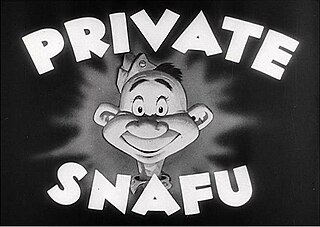
Private Snafu is the title character of a series of black-and-white American instructional adult animated shorts, ironic and humorous in tone, that were produced between 1943 and 1945 during World War II. The films were designed to instruct service personnel about security, proper sanitation habits, booby traps and other military subjects, and to improve troop morale. Primarily, they demonstrate the negative consequences of doing things wrong. The main character's name is a play on the military slang acronym SNAFU, "Situation Normal: All Fucked Up".

John Kirkham Hubley was an American animated film director, art director, producer, and writer known for his work with the United Productions of America (UPA) and his own independent studio, Storyboard, Inc.. A pioneer and innovator in the American animation industry, Hubley pushed for more visually and emotionally complex films than those being produced by contemporaries like the Walt Disney Company and Warner Brothers Animation. He and his second wife, Faith Hubley, who he worked alongside from 1953 onward, were nominated for seven Academy Awards, winning three.

Tortoise Wins by a Hare is a Merrie Melodies cartoon released on February 20, 1943, and directed by Bob Clampett. It stars Bugs Bunny and Cecil Turtle. It is a sequel to 1941's Tortoise Beats Hare, with footage from said cartoon briefly shown at the beginning. It is also the first short to feature Robert McKimson's design of Bugs Bunny.

Herr Meets Hare is a 1945 anti-Nazi Merrie Melodies cartoon directed by Friz Freleng. The short was released on January 13, 1945, and features Bugs Bunny. This short, released not long before the collapse of the Third Reich, was the penultimate wartime themed cartoon from Warner Bros. being released just under four months before Victory in Europe Day.
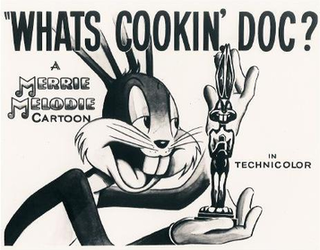
What's Cookin' Doc? is a 1943-produced, 1944 Warner Bros. cartoon in the Merrie Melodies series, directed by Bob Clampett, and stars Bugs Bunny. The short was also written by Michael Sasanoff, and was animated by Robert McKimson, along with uncredited work by Rod Scribner, Phil Monroe and Virgil Ross. The film was released on January 8, 1944.
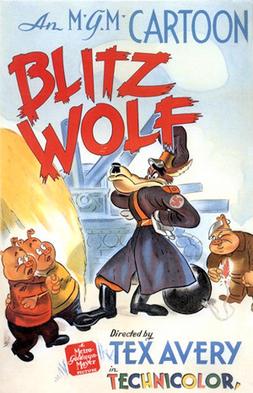
Blitz Wolf is a 1942 American animated propaganda short film produced and distributed by Metro-Goldwyn-Mayer. A parody of the Three Little Pigs told via a World War II perspective, the short was directed by Tex Avery and produced by Fred Quimby. It was nominated for the Academy Award for Best Short Subject: Cartoons but lost to Der Fuehrer's Face, another anti-Nazi World War II parody featuring Donald Duck.

Going Home is part of the Private Snafu series of animated shorts produced by Warner Bros. during World War II. Made in 1944, the 4 minute cartoon features the vocal talents of Mel Blanc and was directed by Chuck Jones. The screenwriters for the Snafu cartoons were typically uncredited, though some animation historians believe that the writer of this short was Dr. Seuss.
Bosko's Picture Show is a Warner Bros. Looney Tunes animated short directed by Hugh Harman and Friz Freleng. It was the last Looney Tunes Bosko cartoon produced by Hugh Harman and Rudolf Ising for Leon Schlesinger and Warner Bros. The duo moved on to produce cartoons for MGM, the first of which were released in 1934. The music score was a work of Frank Marsales.
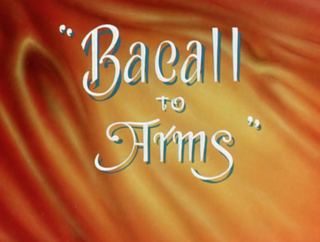
Bacall to Arms is a 1946 Warner Bros. Merrie Melodies series short planned by Bob Clampett and finished by Arthur Davis, in his second-to-last cartoon at Warner Bros. The short was released on August 3, 1946.
David Hilberman was an American animator and one of the founders of classic 1940s animation. An innovator in the animation industry, he co-founded United Productions of America (UPA). The studio gave its artists great freedom and pioneered the modern style of animation. As Animator and Professor Tom Sito noted: "Arguably, no studio since Walt Disney exerted such a great influence on world animation." He and Zack Schwartz went on to start Tempo Productions which became an early leader in television animated commercial production. In short, he played an important role in the new directions the art form took in the 1940s and '50s.

Private Snafu vs. Malaria Mike is an animated short film, directed by Chuck Jones and first released in March 1944. It features Private Snafu facing a malaria-transmitting mosquito.
World War II changed the possibilities for animation. Prior to the war, animation was mostly seen as a form of family entertainment. The attack on Pearl Harbor was a turning point in its utility. On December 8, 1941, the United States Army began working with Walt Disney at his studio, stationing Military personnel there for the duration of the war. The Army and Disney set about making various types of films for several different audiences. Most films meant for the public included some type of propaganda, while films for the troops included training and education about a given topic.

Commando Duck is a Walt Disney anti-Japanese propaganda cartoon starring Donald Duck. It was released on June 2, 1944.

The 1944 United States presidential election in New York took place on November 7, 1944. All contemporary 48 states were part of the 1944 United States presidential election. Voters chose 47 electors to the Electoral College, which selected the president and vice president.
Reason and Emotion is a propaganda short film by Walt Disney Productions, released on August 28, 1943, by RKO Radio Pictures. It was nominated for the Academy Award for Best Animated Short Film in the same year. The short is eight minutes long.
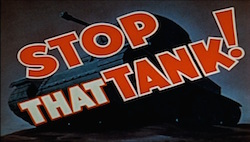
Stop That Tank! is a 22-minute 1942 instructional film created during World War II by Walt Disney Productions for the Directorate of Military Training, The Department of National Defence and the National Film Board of Canada (NFB). Its purpose, akin to "edutainment", was to instruct Canadian soldiers in the handling and care of the Boys Mk.1 Anti-tank rifle for use in combat against Nazi tanks. The film presented information in an entertaining manner as well as providing an anti-Nazi propaganda message.
Events in 1944 in animation.
